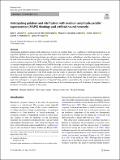| dc.contributor.author | Lennon, Kyle R. | |
| dc.contributor.author | Rathinaraj, Joshua D. J. | |
| dc.contributor.author | Gonzalez Cadena, Miguel A. | |
| dc.contributor.author | Santra, Ashok | |
| dc.contributor.author | McKinley, Gareth H. | |
| dc.contributor.author | Swan, James W. | |
| dc.date.accessioned | 2023-09-21T20:00:12Z | |
| dc.date.available | 2023-09-21T20:00:12Z | |
| dc.date.issued | 2023-09-11 | |
| dc.identifier.uri | https://hdl.handle.net/1721.1/152198 | |
| dc.description.abstract | Abstract
Anticipating qualitative changes in the rheological response of complex fluids (e.g., a gelation or vitrification transition) is an important capability for processing operations that utilize such materials in real-world environments. One class of complex fluids that exhibits distinct rheological states are soft glassy materials such as colloidal gels and clay dispersions, which can be well characterized by the soft glassy rheology (SGR) model. We first solve the model equations for the time-dependent, weakly nonlinear response of the SGR model. With this analytical solution, we show that the weak nonlinearities measured via medium amplitude parallel superposition (MAPS) rheology can be used to anticipate the rheological aging transitions in the linear response of soft glassy materials. This is a rheological version of a technique called structural health monitoring used widely in civil and aerospace engineering. We design and train artificial neural networks (ANNs) that are capable of quickly inferring the parameters of the SGR model from the results of sequential MAPS experiments. The combination of these data-rich experiments and machine learning tools to provide a surrogate for computationally expensive viscoelastic constitutive equations allows for rapid experimental characterization of the rheological state of soft glassy materials. We apply this technique to an aging dispersion of Laponite® clay particles approaching the gel point and demonstrate that a trained ANN can provide real-time detection of transitions in the nonlinear response well in advance of incipient changes in the linear viscoelastic response of the system. | en_US |
| dc.publisher | Springer Berlin Heidelberg | en_US |
| dc.relation.isversionof | https://doi.org/10.1007/s00397-023-01407-x | en_US |
| dc.rights | Creative Commons Attribution | en_US |
| dc.rights.uri | https://creativecommons.org/licenses/by/4.0/ | en_US |
| dc.source | Springer Berlin Heidelberg | en_US |
| dc.title | Anticipating gelation and vitrification with medium amplitude parallel superposition (MAPS) rheology and artificial neural networks | en_US |
| dc.type | Article | en_US |
| dc.identifier.citation | Lennon, Kyle R., Rathinaraj, Joshua D. J., Gonzalez Cadena, Miguel A., Santra, Ashok, McKinley, Gareth H. et al. 2023. "Anticipating gelation and vitrification with medium amplitude parallel superposition (MAPS) rheology and artificial neural networks." | |
| dc.contributor.department | Massachusetts Institute of Technology. Department of Chemical Engineering | |
| dc.contributor.department | Massachusetts Institute of Technology. Department of Mechanical Engineering | |
| dc.identifier.mitlicense | PUBLISHER_CC | |
| dc.eprint.version | Final published version | en_US |
| dc.type.uri | http://purl.org/eprint/type/JournalArticle | en_US |
| eprint.status | http://purl.org/eprint/status/PeerReviewed | en_US |
| dc.date.updated | 2023-09-17T03:09:57Z | |
| dc.language.rfc3066 | en | |
| dc.rights.holder | The Author(s) | |
| dspace.embargo.terms | N | |
| dspace.date.submission | 2023-09-17T03:09:57Z | |
| mit.license | PUBLISHER_CC | |
| mit.metadata.status | Authority Work and Publication Information Needed | en_US |
